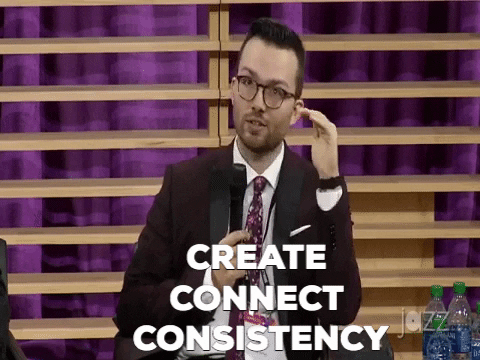Crafting Impactful Product Messaging: The Forgotten Art of Storytelling in B2B
Messaging will make or break anything you’re trying to sell.

B2C companies often prioritize emotive and narrative-driven messaging to resonate with their customers' needs, desires, and aspirations.
B2B messaging is more feature- and benefit-focused, addressing clients' business needs, challenges, and ROI.
To illustrate these differences in messaging approaches, let's examine how five renowned B2B SaaS companies effectively communicate their value proposition.
Each example offers unique insights into how messaging can be tailored to highlight product features and benefits and resonate deeply with specific business audiences.
Slack: "Slack replaces email inside your company"
Salesforce: "Customer Relationship Management Solutions"
Dropbox: "Keep life organized and work moving—all in one place."
Shopify: "Anyone, anywhere, can start a business."
Zoom: "Bringing the world together, one meeting at a time."
We aim to uncover actionable insights and a replicable framework for effective B2B SaaS messaging by dissecting these examples.
TL;DR:
7 Steps to crafting compelling messaging for B2B SaaS Product
The Power of Storytelling
Understanding the Audience
Defining Your Product's Unique Value Proposition
Crafting a core message
Incorporating Emotional Appeal
Testing and Refining the Message
Consistency Across Channels
The Power of Storytelling
Imagine a startup founder, Jack, who developed an innovative Project management tool. Despite its advanced features and required marketing efforts, it needed to gain traction.
Enters Sarah, a seasoned product marketer who crafts messaging around the tool's features and connects it to compelling stories about struggling teams that benefited from it.
The new message profoundly resonates with the customers and drives engagement and sales.
The story illustrates the power of effective product messaging.
Developed initially as an internal tool for a gaming company, Slack began to gain traction when it shifted its messaging to focus on how its tool could revolutionize team communication by reducing email overload.
This narrative, highlighting a common pain point and offering a clear, compelling solution, resonated deeply with their target audience, leading to widespread adoption and success.
It's not just about listing the features but about weaving the narratives that connect your products to the customers' lives.
Understanding the Audience
In B2B Messaging, understanding your audience is paramount. It is about recognizing all segments of your target audience, their unique needs and preferences, and tailoring your messaging to their needs.
Identifying your audience: Identify your primary and secondary target audience segments. Use market research, customer interviews, and data analysis to gather comprehensive information on your target segment.
Needs and Preference: Use surveys and interviews to identify your target audience's needs and preferences. Visit third-party review sites and forums to learn what your audience wants.
Pain points: Identifying customers' challenges is crucial. Analyze customer feedback and market trends. Find common keywords that represent challenges on the third-party sites if you need customer data.
Build Personas and customer lifecycle: Create a detailed customer persona based on your research. This helps in crafting messaging that resonates with the target profile. Understanding the customer lifecycle also helps deliver the right message and time.
Continuous Learning: The audience's needs and the market are dynamic and keep evolving, and your messaging should grow with them. It's essential to go back to the messaging exercise once every month or quarter, depending on your business, and look at the marketing trends.
*Top Tip - Scour through competitor reviews on third-party review sites like G2Crowd and create a list of common keywords mentioned in the problem they were looking to solve. Similarly, list keywords mentioned on how the competitor has solved the issue.
Taking Slack as an example again, its messaging, "Slack replaces email inside your company," shows a deep understanding of its audience's need for efficient communication. Their approach demonstrates how well they know their target market's pain points.
Another example that you can refer to -
Shopify: "Anyone, anywhere, can start a business."
Audience's Needs: Starting an online business quickly.
Unique Features: User-friendly e-commerce platform.
Benefits: Empower users to start their business.
Messaging: Inclusive and empowering, highlighting accessibility.
Defining Your Product's Unique Value Proposition
The product's unique value proposition is the cornerstone of your messaging framework. A clear UVP helps your product stand out in a crowded market but also helps drive attention and boost conversions.
Start by listing your product's unique features. Think of all that differentiates you from your competitor. It could be a product feature, customer service, pricing model, or something else.
Most consumers want to understand what a product can do for them. Translate your unique feature into a tangible benefit for the customer. Demonstrate how the UVP would help them reach the promised land.
Create a clear, concise, and compelling statement that combines the unique value proposition with the product offering that resonates with the target audience.
Test your UVP with a segment of your target audience. Gather feedback and refine it to ensure it resonates with them.
Let's take Salesforce messaging as an example
Salesforce: "Customer Relationship Management Solutions"
Audience's Needs: Managing customer relationships efficiently.
Unique Features: Comprehensive CRM tool.
Benefits: Improved customer engagement and sales.
Messaging: Straightforward, focuses on CRM solutions.
Salesforce messaging clearly articulates its Unique Value in offering a comprehensive CRM tool. This highlights the importance of defining a UVP that resonates with specific business needs.
Another great example to refer
HubSpot, initially known for its inbound marketing software, strategically expanded its messaging to encompass a broader range of CRM tools and services.
This transition allowed HubSpot to target a more comprehensive business audience, addressing various customer management and marketing needs. Their messaging evolution mirrored this shift, focusing on complete, integrated business solutions.
*Tip - Highlight the UVP with statistics if possible. Relatable statistics help underscore the impact of UVP.
Crafting a core message
Crafting a compelling core message for your B2B product is like distilling its essence - what problem will it solve, or how does it enhance the users' experience?
Next, identify your product's unique features and translate them into benefits that resonate with customer needs.
The objective is to develop a clear and concise message and to bring out the essence of your products and their value proposition. Ensure that the message is relevant and targeted to your audience.
Once your core message is crafted, test this message with a small segment of your audience. Keep refining it as you receive the feedback.
Let's understand this with the DropBox example.
Dropbox: "Keep life organized and work moving—all in one place."
Audience's Needs: Organizing files and facilitating work.
Unique Features: Cloud storage is accessible from anywhere.
Benefits: Streamlined organization and workflow.
Messaging: Emphasizes the all-in-one solution for work and life.
"Keep life organized and work moving—all in one place," by Dropbox, exemplifies a clear and benefit-focused core message, aligning with their customers' streamlined workflow needs.
Incorporating Emotional Appeal
Often, B2B messaging is dry of emotion, talking only about features and products. Emotional appeal in messaging is about connecting with your audience beyond features and benefits, tapping into aspects that drive business decision-making.
While crafting the messaging, it is essential to understand the emotional appeal of your persona - their desire for success and innovation. Crafting a message that speaks to these emotional needs and showing how your product supports these aspirations is extremely important.
Research indicates that emotional factors significantly influence B2B buyers. A CEB study found that B2B customers are more emotionally connected to their vendors than consumers.
Use your storytelling skills to create a narrative the audience can relate to, such as overcoming a business challenge your product solves. Messaging with a story humanizes a brand and makes it more relatable.
Emotionally engaged customers are three times more likely to recommend a product than to re-purchase.
IBM's "Let's Put Smart to Work" campaign is a great example. It goes beyond the technical prowess of IBM's solutions and taps into the emotional aspect of innovation and making the world better through technology.
Incorporating emotional elements into your messaging can transform how users perceive your product.
Testing and Refining the Message
While crafting messaging requires much research and analysis, testing and refining the message constantly becomes essential. Below are a few ways to test your messaging -
A/B Testing - Conduct A/B tests by sending two variations of your message to a small audience segment—track which version garners more engagement or conversions.
Feedback Surveys - After message exposure, use surveys to gather direct feedback from the audience. Ask specific questions about message clarity, relevance, and persuasiveness.
Focus Groups - Organize focus groups with a sample of your target audience. Discuss the messaging in-depth to gain qualitative insights.
Refining your messaging
Analyze the data from these tests to understand what aspects of your messaging resonate the most. Make necessary adjustments, focusing on the elements that received positive responses.
Consistency Across Channels
In B2B marketing, ensuring that the message remains consistent across all the channels is as essential as the message itself. A unified core message should be the backbone for all your communication on your website, social media, Press release, or email.
However, tailoring your messaging to the platform's nuances becomes essential, retaining the message's essence. Ensure that the message is being regularly monitored and updated while maintaining uniformity.
Conclusion
In conclusion, creating an effective messaging strategy for your B2B product requires understanding your audience, defining the unique value proposition, and ensuring uniformity across the marketing channels.
The key to successful messaging lies in keeping your messaging up to date with the changing dynamics and requirements of your consumer and target audience.
The journey of perfecting your product's message is ongoing and demands adaptability.
Want to skyrocket your SaaS growth 🎢?
Let's dive into a strategy session and uncover the secrets to scaling your business faster. 🏎️
You may also like -
If you find this newsletter valuable, share it with a friend, and consider subscribing if you haven’t already.






